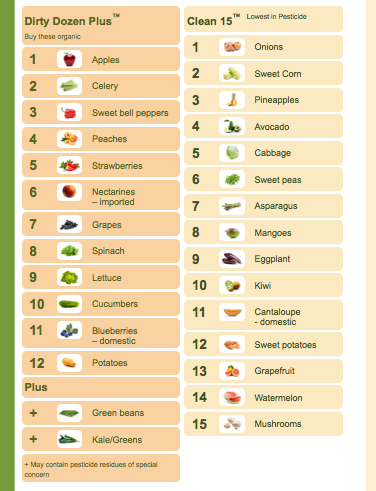To Buy or Not To Buy Organic?
June 27, 2012 by PinoyOrganics
Filed under Green Exchange
Environmental Working Group, a non-profit research organization that protects human and health and the environment, has released the eighth edition of its Shopper’s Guide to Pesticides in Produce with updated information on 45 popular fruits and vegetables and their total pesticide loads. EWG highlights the worst offenders with its new Dirty Dozen Plus™ list and the cleanest conventional produce with its list of the Clean Fifteen™.
EWG researchers analyzed annual pesticide residue tests conducted by the USDA and Federal Food and Drug Administration between 2000 and 2010. The samples were first washed or peeled prior to being tested so the rankings reflect the amounts of the crop chemicals likely present on the food when it is eaten.
The USDA and FDA tests have produced hard evidence of widespread presence of pesticide residues on conventional crops. The most recent round of tests shows that as late as 2010, 68 percent of food samples had detectable pesticide residues. EWG found striking differences between the number of pesticides and amount of pesticides detected on the Dirty Dozen Plusâ„¢and Clean Fifteenâ„¢ foods.

Here are some of their notable findings:
- Some 98 percent of conventional apples have detectable levels of pesticides.
- Domestic blueberries tested positive for 42 different pesticide residues.
- Seventy-eight different pesticides were found on lettuce samples.
- Every single nectarine USDA tested had measurable pesticide residues.
- As a category, grapes have more types of pesticides than any other fruit, with 64 different chemicals.
- Thirteen different pesticides were measured on a single sample each of celery and strawberries.
For the past eight years, EWG has scrutinized pesticide testing data generated by scientists at USDA and FDA and has created its signature Dirty Dozenâ„¢ list of foods most commonly contaminated with pesticides.
This year they have expanded the Dirty Dozenâ„¢ with a Plus category to highlight two crops — green beans and leafy greens, meaning, kale and collard greens – that did not meet traditional Dirty Dozenâ„¢ criteria but were commonly contaminated with highly toxic organophosphate insecticides. These insecticides are toxic to the nervous system and have been largely removed from agriculture over the past decade. But they are not banned and still show up on some food crops. For this reason, EWG lists these on the new Dirty Dozen Plusâ„¢ as foods to avoid or to buy organic.
As a Filipino, how are we affected by this? If you go to your nearby city grocer or supermarket, check out your fruits and vegetable section. Grapes, oranges and those waxed shiny red Washington apples are all imported. How they survive the number of days to get to Manila and stay in your grocer’s display racks is another story.
So, this weekend, buy local fruits and vegetables in your nearby palengke instead. Better yet, go to a weekend market and get to know your local producers and farmers. Local fruits, vegetables and other farm products sold in most, if not all, weekend markets were harvested either Friday afternoon or just a few hours before they left the farm. Local produce are cheaper, healthier and believe me, even yummier.
Can you share with us where you buy the freshest local fruits and vegetables in your city?